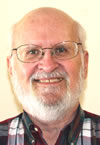As you all may well know, a monument suddenly appeared in front of the Donley County Courthouse Annex a couple of weeks ago. Most folks knew it was coming, so it’s not a great surprise. On it, many statements were attributed to several Founding Fathers, along with others, including the Ten Commandments. Anyway, with all the engraving that was done on the monument I wonder if it is, in effect, a graven image? Just kidding – well, sort of.

Even though the monument is a weighty thing, I wonder what the point of it is. What is its purpose? What are the people behind the monument trying to say? For example, the monument includes statements attributed to George Washington, James Madison, John Jay, and alas, Patrick Henry, among others. Why, “alas” Patrick Henry? Because the monument uses a bogus quote attributed to Patrick Henry, in a 1956 magazine article. The quote is as follows, “It cannot be emphasized too strongly or too often that this great nation was founded, not by religionists, but by Christians; not on religions, but on the gospel of Jesus Christ!”
Several respectable sources dispute that Patrick Henry actually wrote or said this. Unfortunately, according to the Huffington Post, “the quotation still appears regularly in Facebook and Twitter posts, and, remarkably, in presidential aspirant Newt Gingrich’s 2011 book, A Nation Like No Other (p. 76). And this from the only candidate with a history Ph.D.!”
“It is what it is, a totally inaccurate statement,” according to my publisher Roger Estlack. It is puzzling as to why the quotes on the monument were not properly vetted. Actually, it is highly embarrassing that a false quote is now forever memorialized in front of the Courthouse Annex. We may have a possible $20,000 “oops” setting in our front yard.
There is also a misspelling or misuse of a word included in the history of Clarendon at the back of the monument. The history reads, “…purchased large tracks of land…” Actually, it should read, “…purchased large tracts of land…” Of course, they could have been referring to dinosaur, train, or animal tracks that can be found in the neighborhood. The monument also mistakenly uses the word “purposed” instead of “proposed.”
Finally, I get the feeling that the people who placed this monument may have intended it to suggest that our nation was founded on Christian values. If so, nothing could be farther from the truth. While many of the Founding Fathers were Christians, the Constitution and structure of the country were based strictly upon Enlightenment principles.
Most Americans seem to be under the erroneous idea that the Founding Fathers were pious, prayerful men. That is not the case. They were skeptical men of the Enlightenment who questioned each and every idea that they were taught. They were very well read in political philosophy and science, and were well versed in theological matters. They continually challenged the religious teachings they heard, both publicly and privately.
For example, Thomas Jefferson counseled his nephew to subject the authors of the New Testament to the same textual scrutiny he would give to other ancient historians like Tacitus or Livy, and to treat the supposed biblical miracles with suspicion. Jefferson himself edited a version of the New Testament that left out every miraculous and supernatural event, leaving only Jesus’ moral teachings.
George Washington, on the other hand, rewrote the presidential addresses crafted for him by his speechwriters so as to omit all references to Jesus Christ. And James Madison, who was quoted on the monument, gave his opinion that, “Religious bondage shackles and debilitates the mind and unfits it for every noble enterprise, every expanded subject.”
The era of the Founding Fathers was not an age of faith but an age of science and skepticism, and the Founding Fathers were in the lead. The American Revolution, and the subsequent founding of the United States of America, embodied the Enlightenment values that had been formulated over the previous hundred years or so. Our American experiment was originally an Enlightenment experiment.
I think the monument would be better placed in front of a church or even on private property. It has no place in front of our magnificent courthouse, a true monument to local government, and a temple of justice. I agree with Jefferson and the Founding Fathers that there must always be a wall separating church and state. The mystery monument is located in the wrong place, for the wrong reasons.


Leave a Reply
You must be logged in to post a comment.